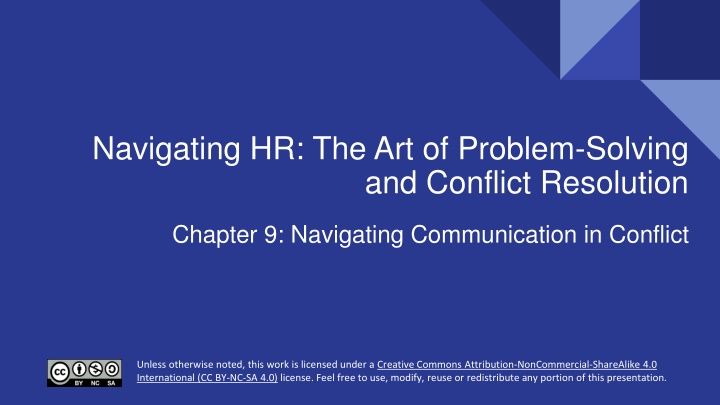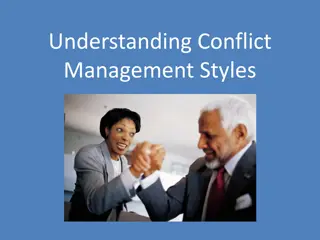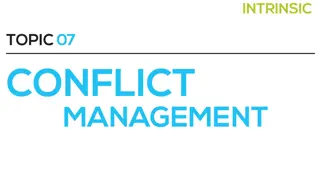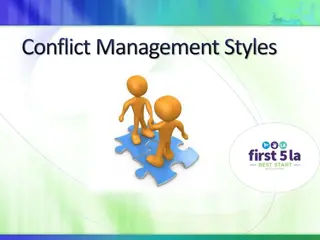Navigating Communication Strategies in Conflict Resolution
This chapter delves into verbal communication essentials for conflict resolution. Learn how expressing observations, thoughts, feelings, and needs can enhance communication effectiveness in challenging situations.
Download Presentation

Please find below an Image/Link to download the presentation.
The content on the website is provided AS IS for your information and personal use only. It may not be sold, licensed, or shared on other websites without obtaining consent from the author.If you encounter any issues during the download, it is possible that the publisher has removed the file from their server.
You are allowed to download the files provided on this website for personal or commercial use, subject to the condition that they are used lawfully. All files are the property of their respective owners.
The content on the website is provided AS IS for your information and personal use only. It may not be sold, licensed, or shared on other websites without obtaining consent from the author.
E N D
Presentation Transcript
Navigating HR: The Art of Problem-Solving and Conflict Resolution Chapter 9: Navigating Communication in Conflict Creative Commons Attribution-NonCommercial-ShareAlike 4.0 International (CC BY-NC-SA 4.0) Creative Commons Attribution-NonCommercial-ShareAlike 4.0 International (CC BY-NC-SA 4.0) Unless otherwise noted, this work is licensed under a Creative Commons Attribution-NonCommercial-ShareAlike 4.0 International (CC BY-NC-SA 4.0) license. Feel free to use, modify, reuse or redistribute any portion of this presentation.
9.0 Learning Outcomes In this chapter, we will: Identify forms of verbal and non-verbal communication used in conflict resolution. Examine emotional intelligence and the importance of remaining calm in conflict. Practice remaining calm in a difficult workplace scenario.
9.2 The Lesson: Communication Essentials Verbal Communication Verbal communication allows us to meet instrumental needs by asking questions and describing things, people, and ideas. It serves to inform, persuade, and entertain, aligning with the general purposes of public speaking. Language is inherently expressive, helping us share observations, thoughts, feelings, and needs. Verbal expressions play a key role in forming and maintaining relationships. Image Image by pikisuperstar, Freepik License pikisuperstar Freepik License
9.2 Verbal Communication Strategies Expressing Observations Observations involve reporting sensory information, focusing on what we see, hear, or feel. Describing observations instead of evaluating them reduces defensiveness and promotes effective communication. Observations form the first step in the perception-checking process, helping us understand experiences. Expressing observations descriptively facilitates more competent communication. Expressing Thoughts Thoughts are conclusions drawn by interpreting sensory observations and assigning meaning. They are influenced by beliefs (true/false), attitudes (like/dislike), and values (right/wrong). Thoughts can sometimes be miscommunicated as feelings, leading to potential confusion. Expressing thoughts helps clarify perspectives, as seen in contexts like jury deliberations.
9.2 Verbal Communication Strategies (continued) Expressing Feelings Feelings communicate emotions but are influenced by norms around when, where, and to whom they are expressed. Cultural, age, and gender norms shape emotional expression, with women often expected to be more expressive than men. Sharing emotions strengthens social bonds, but it can be challenging for listeners to process. Expanding emotional vocabulary allows clearer communication of intensity, improving empathy and understanding. Expressing Needs Needs communication is instrumental in getting tasks done and maintaining healthy relationships. Clearly expressing needs prevents frustration and resentment by providing actionable guidance. Effective need expression avoids judgmental language, focusing instead on specific requests or solutions. Stating needs clearly helps others understand and respond appropriately, improving communication outcomes.
9.2 Language Is Relational Verbal communication helps initiate interpersonal relationships by allowing us to assess potential partners or friends. Early exchanges help determine whether to pursue a relationship further. It is used to maintain relationships by expressing feelings and checking in with others. Verbal communication supports relationship maintenance through affirmations and dialogue. Image Image by pikisuperstar, Freepik License pikisuperstar Freepik License It is also a key tool for ending relationships when negative feelings persist or other issues arise.
9.2 Language Can Bring Us Together Verbal communication fosters connection and maintains relationships, influenced by the intentional or unintentional use of pronouns like "I," "you," and "we. "We language" (e.g., we, our, us) promotes inclusiveness, while "I language" helps express personal emotions and avoid attributing blame. "You language" can lead to defensiveness, making others feel attacked and potentially causing separation. Frequent and supportive communication reduces stress and uncertainty in relationships, helping partners feel more connected. Unsupportive messages, such as sarcasm, negative comparisons, or judgmental "you" statements, can escalate conflict and harm relationships. Consistently unsupportive communication can lower self-esteem, create a toxic environment, and lead to the dissolution of relationships.
9.2 Common Types of Unsupportive Messages Global labels: Sweeping judgments like "You're a liar" question a person's entire identity and escalate negativity. Sarcasm: Disguised as humor, sarcasm often communicates passive-aggressive negativity. Dragging up the past: Referencing past grievances avoids addressing current issues and releases pent-up negative feelings. Negative comparisons: Comparing someone to others fosters feelings of inferiority and resentment. Judgmental "you" messages: Accusatory overgeneralizations fail to address specific behaviors and hinder constructive communication. Threats: Threats of violence or consequences end productive dialogue and reflect insecurity.
9.2 What is Non-Verbal Communication? Non-verbal communication conveys emotions and attitudes without words, using gestures, facial expressions, and body language. It allows us to express feelings like boredom, agitation, or surprise naturally and effectively. Non-verbal signals can complement, modify, or contradict verbal messages. Like verbal communication, non-verbal communication includes various categories that work together to create meaning. Understanding non-verbal communication enhances our ability to interpret and convey nuanced messages.
9.2 Three Types of Gestures Adaptors: Touching behaviors and movements indicating internal states, often linked to anxiety or unease. Common in social situations and public speaking, such as fidgeting, clicking pens, or scratching. Emblems: Gestures with specific, culturally agreed meanings, like the thumbs-up or "OK" sign. These gestures can be still or in motion and convey a clear message within a culture. Illustrators: Gestures that illustrate or emphasize the verbal message, such as showing the size or shape of an object. These largely involuntary gestures vary in intensity and frequency depending on the context.
9.2 Non-Verbal Communication Head Movements and Posture: Head nods are universal signs of acknowledgment, often replacing formal bows. The headshake is an innate signal for rejection, beginning at birth. Eye Contact: Eye contact regulates interactions, signals when to speak, and indicates listening. It helps monitor communication, conveys engagement, and expresses cognitive activity or emotion. Facial Expressions: Facial expressions like happiness, sadness, and anger are universally recognizable. Smiles often serve social purposes, not just as responses to internal emotions.
9.2 Examples of Non-Verbal Communication Rolling Your Eyes: Indicates disagreement or disbelief, signaling a negative reaction to what was just said. Arms Crossed: Can suggest deep thought or closed body language, implying disagreement or discomfort with the conversation. Hands on Your Hips: May be a comfortable stance for some but can also appear intimidating or signal frustration to others. Looking Away: Often a sign of thinking or processing information but can be perceived as boredom by others. Hands Clenched: Indicates frustration, anxiety, or nervousness about the situation.
9.3 Spotlight on Human Resources Skills Emotional intelligence (EQ) is the ability to understand, manage, and use emotions to relieve stress, communicate effectively, empathize with others, and resolve conflicts, which is just as important as intellectual ability for building relationships, achieving goals, and making informed decisions. Four key attributes of emotional intelligence: Self-management: Control impulsive behaviors, manage emotions healthily, stay committed, and adapt to changes. Self-awareness: Recognize emotions, understand their impact, and know personal strengths and weaknesses. Social awareness: Empathize with others, understand emotional cues, and navigate social dynamics. Relationship management: Build and maintain relationships, communicate clearly, inspire others, and manage conflict.
9.3 Why is Emotional Intelligence so Important? Work performance: High EQ helps you navigate social complexities, lead others, and excel in your career, with many companies now valuing EQ as much as technical skills. Physical health: Poor emotional management can lead to stress-related health problems like high blood pressure, heart disease, and weakened immune function. Mental health: Uncontrolled emotions and stress can contribute to anxiety, depression, and difficulty forming strong relationships, affecting overall mental well-being. Relationships: Understanding and controlling emotions allows better communication, helping to build stronger personal and professional relationships. Social intelligence: EQ helps you connect with others, understand social cues, and balance your emotions, improving social interactions and overall happiness.
9.3 Emotional Intelligence Skills and Competencies Self-awareness (Personal): Recognizing and understanding one's emotions, strengths, and weaknesses. Self-regulation (Personal): Managing and controlling one s emotions and behaviors in a healthy way. Motivation (Personal): Using emotions and passions to pursue and achieve goals. Empathy (Social): Understanding and showing compassion for others emotions and perspectives. Social skills (Social): Inspiring, influencing, and collaborating effectively with others.
9.6 Chapter Summary Verbal communication is one way of expressing your observations, thoughts, feelings and needs. Ensure you are providing supportive messages rather than unsupportive messages. Non-verbal communication can be helpful if it includes direct eye contact, indicating you are listening to the speaker. Non-verbal communication can be challenging if it includes sitting with your arms crossed in front of you, which can be seen as closed body language. Emotional Intelligence, or EI allows you to determine if you are too upset to enter into a conversation. Presenting a calm approach in a difficult conversation makes the other person feel safe.























